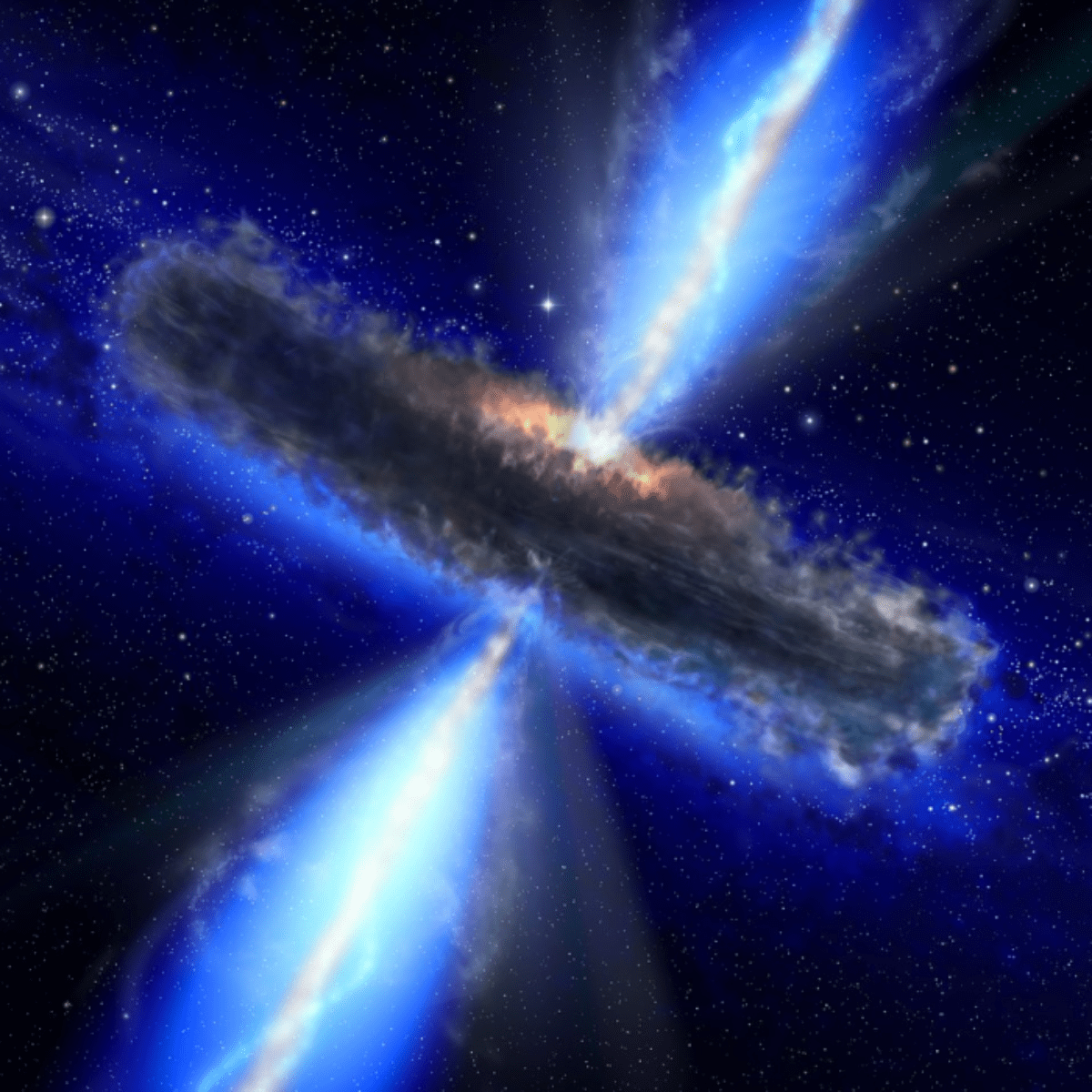
Artistic conception of an AGN shows the large torus of gas and dust which surrounds the inner accretion disk and the supermassive black hole. (Illustration: ESA/NASA, the AVO project and Paolo Padovani)
Research investigates the fragmentation of complex molecules around active galaxy nuclei
A galaxy is a gravitationally bound system made up of stars, gases – mainly hydrogen and helium – and, to a lesser extent, other heavier chemical elements. The visible universe is estimated to house trillions of galaxies and each galaxy is estimated to contain from a few hundred million ($ \rm 10^8 $) to one hundred trillion ($ \rm 10^{14} $) stars. The galaxy where we are located is called the Milky Way and our Sun orbits the galactic center at a distance of 27,000 light-years (one light-year is the distance light travels in a year, approximately 10 trillion kilometers).
Observational evidence suggests that the center of almost all large galaxies, including the Milky Way, is made up of a supermassive black hole, millions or even billions of times more massive than our Sun. A portion of these galaxies have luminosity in some ranges of the electromagnetic spectrum – from radio waves to gamma rays – incompatible with what would be produced by their stars only. They have what is called an active galactic nucleus (AGN) and are among the greatest energy sources in the universe.
AGNs have varying observational properties but can be described by a unified model. This model consists of a supermassive black hole surrounded by an accretion disk and, at a greater distance, a thick cloud of gas and dust distributed in a toroidal shape. As the surrounding matter of the accretion disc falls toward the black hole, the material is heated and radiates photons in various bands of the electromagnetic spectrum, especially X-rays. It is estimated that this emitting region has a diameter on scale of tenths of a light-year. The matter contained in the torus, in turn, obscures the brightness of the AGN, which can only be viewed depending on its orientation with respect to Earth. From observations, it can be inferred that near the AGN the gas is completely ionized due to interaction with x-rays, while the torus would have sufficient opacity to absorb some of the AGN luminosity and allow molecules to survive in more external regions where large molecular clouds form.
In fact, molecular clouds are observed at distances less than 100 light-years from the AGN. These clouds are made up of molecules as simple as carbon monoxide ($ \rm CO $) to large polycyclic aromatic hydrocarbons (PAHs), the precursors of graphene. PAHs are estimated to be one of the main carbon sources in the universe, in addition to carbon monoxide clouds. Because of the typical aromatic chemical bonds of these compounds, PAHs are also extremely stable and resistant to degradation, including by ultraviolet radiation. Because of this stability, they are observed in the most diverse astrophysical environments, both in the Milky Way and other galaxies, including the vicinity of AGNs.
Upon collisions or interaction with light, molecules are stimulated and respond by reemitting energy as electromagnetic radiation in the infrared and radio bands. This emission is very specific to each type of molecule, acting like a fingerprint indicating their presence. Hence, it is possible to estimate the amount of certain molecule in space, even in very distant regions, through telescopes on the Earth’s surface or in orbit.
The investigation on how PAHs form and degrade under various conditions in astrophysical environments allows us not only to understand the formation of organic molecules in these extreme environments. It can also help us understanding how organic matter is distributed in the universe and its role in forming planetary systems, including our Solar System, as it is estimated that 80% of organic material in meteorites is in the form of PAHs.
In this context, Thiago Monfredini et al. [1] experimentally examined the interaction of PAHs with x-rays to estimate the fragmentation of these molecules and the production of new molecular ions near AGNs. The researchers used the SGM and SXS beamlines from the Brazilian Synchrotron Light Laboratory (LNLS) to verify the degrees of ionization and molecular destruction resulting from the interaction of PAHs with x-rays.
The group determined that the estimated optical opacity for current AGN torus models is insufficient to explain the presence of PAHs in these regions. Although the molecules are very stable, they would be easily fragmented by AGN x-rays, even considering the upper limits established by torus opacity models.
Assuming that the observational estimates of opacity are correct, the researchers argue that more detailed studies are needed on more efficient molecular formation processes that could explain the abundance of PAHs near AGNs and other astrophysical regions.
The work was published in the Montly Notices of the Royal Astronomical Society, one of the world’s leading astronomical journals. The research was coordinated by Prof. Dr. Heloísa M. Boechat-Roberty of the Federal University of Rio de Janeiro, Brazil.
Source: [1] Thiago Monfredini, Heidy M. Quitián-Lara, Felipe Fantuzzi, Wania Wolff, Edgar Mendoza, Alexsandre F. Lago, Dinalva A. Sales, Miriani G. Pastoriza, Heloisa M. Boechat-Roberty, Destruction and multiple ionization of PAHs by X-rays in circumnuclear regions of AGNs, Monthly Notices of the Royal Astronomical Society, Volume 488, Issue 1, September 2019, Pages 451–469. DOI: 10.1093/mnras/stz1021.
Researchers report unprecedented toxicological analysis of multifunctional nanoparticles
Research investigates effect of additive manufacturing on aerospace materials